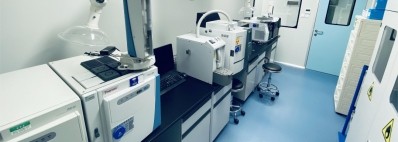Promotional Features
A bioavailable form of berberine for enhanced health outcomes and efficiencies in supplement production
With the evolution of the food industry and modern lifestyle changes, health issues such as obesity, diabetes, and cardiovascular disease have become significant threats to health and wellbeing.
These health issues might be caused by metabolic disorders or metabolic syndrome.1 Therefore, keeping a healthy metabolic function, especially blood glucose level, is the key to health management.
These issues not only impact individual health and quality of life but also place a substantial burden on society and the healthcare system. In response, brands have introduced various products to address weight loss and blood glucose control needs. Berberine has gained popularity for its multiple health benefits, including blood glucose and lipid regulation capabilities.
Since 2022, berberine has gone viral on TikTok in the US, catalyzed by a user sharing her successful weight loss journey with the supplement. These short videos garnered widespread attention, and the internet quickly dubbed berberine ‘Nature’s Ozempic’.
Experiences related to weight loss using berberine amassed billions of views, leading to a dramatic surge in demand. Many berberine products sold out, even causing a shortage of raw materials.
Berberine: The natural glucagon-like peptide-1 (GLP-1) stimulator
Berberine, primarily from plants with a long history of use, was first recorded in ancient Chinese medical ‘Shen-nong's Herbal Classics’ over 3,000 years ago. Initially, berberine was mainly used for its antibacterial, antiviral, and diarrheal relief properties.
In recent years, modern science has gradually uncovered various pharmacological effects of berberine, leading to its widespread use in clinical practice. Research has found that berberine exerts its health benefits through several mechanisms.
Key benefits of berberine and related health benefits
1. Promotes GLP-1 secretion
- Increases GLP-1 secretion by promoting the expression of glucagon mRNA and the proliferation of intestinal L-cells.2
- Activates the bitter taste receptor TAS2R38 in the intestine, stimulating GLP-1 secretion from L-cells.2
2. Regulates blood sugar metabolism and improves insulin resistance
- Stimulates insulin receptor expression, enhances insulin sensitivity and improves insulin resistance.3
- Upregulates glucose transporter type 4 (Glut4) expression, promoting glucose uptake by cells and reducing blood glucose levels.4
- Reduces oxygen consumption and ATP production in mitochondria, and inhibits the expression of gluconeogenesis transcription factors (G6Pase and PEPCK), thereby lowering fasting blood sugar levels.5
3. Increases brown fat content and improves fat metabolism
- Promotes the expression of browning genes in white adipose tissue, increasing brown fat quantity and enhancing brown tissue function, leading to increased energy expenditure and thermogenesis.6
- Inhibits the expression of transcription factors related to fat production (SREBPs and ChREBP) via the AMPKα pathway, reducing fat synthesis enzyme levels and improving fat metabolism.7,8
4. Regulates cholesterol metabolism
- Downregulates the expression of acyl-CoA cholesterol acyltransferase-2, reducing cholesterol uptake and cell monolayer permeability.9
- Upregulates the gene expression of sterol 27-hydroxylase and cholesterol-7α-hydroxylase, inhibiting intestinal cholesterol absorption.10
- Lowers levels of plasma LDL cholesterol, free fatty acids (FFAs), and total cholesterol via the AMPK pathway while increasing HDL cholesterol levels.11,12
5. Reduces inflammation and oxidative stress damage
- Exerts anti-inflammatory effects by inhibiting cyclooxygenase-2 expression through the suppression of AP-1 binding.13
- Modulates oxidative stress markers and antioxidant enzyme levels through complex mechanisms like AMPK activation, NF-κB and AP-1 pathway inhibition, and Nrf2 pathway regulation, reducing pro-inflammatory cytokine levels.13
The limitations of berberine in practical applications
Despite the huge enthusiasm for berberine, scientific studies have found limitations in its application, such as low bioavailability, poor intestinal absorption, and potential irritations on the GI tract.14
Sub-chronic toxicity of berberine indicates the potential damage of lung and liver in animal at very high dosage.15 This has motivated Bonerge to step forward to test the safety of berberine and Dihydroberberine.
Figure 1: Reasons causing limited bioavailability of Berberine.16
Dihydroberberine: A more bioavailable form of berberine
Dihydroberberine is a research-proven bioactive form of berberine derivative. When berberine is orally ingested, it is reduced to Dihydroberberine in the intestine, absorbed through the intestinal wall, and then converted back to berberine in the blood to exert its effects. Thus, Dihydroberberine can be absorbed more rapidly by the intestinal wall, resulting in higher bioavailability compared to berberine.17
Figure 2: Berberine absorption mechanism in intestine.17
Although Dihydroberberine is a relatively new product for the weight-loss market, its efficacy has been proven by both in vivo and in vitro studies. Dihydroberberine has a better absorption rate and greater potency than berberine.17
Better absorption efficiency
- In vitro studies using the Caco-2 cell model of human colon cancer cells show that Dihydroberberine’s absorption rate is 11.9 times that of berberine, with an efflux ratio 1/20 of berberine.17
- In a study conducted on mice, the absorption blood concentration curve area AUC(0-t) of berberine is 54.57, while the AUC(0-t) of Dihydroberberine is 261.8, indicating that the bioavailability of Dihydroberberine is 4.8 times that of berberine.17
Better health benefits
Better blood glucose lowering effect Dihydroberberine displayed a similar effect to berberine to stimulate glucose uptake and AMP-activated protein kinase (AMPK). Activating AMPK increases glucose metabolism.18 In High Fat Diet (HFD) rat model, Dihydroberberine at 100 mg/kg has comparable or superior blood sugar lowering effects to berberine at 560 mg/kg.19
Enhanced insulin sensitivity Dihydroberberine improves whole-body insulin sensitivity in HFD rats by increasing the uptake of glucose into peripheral tissues. The glucose infusion rate was 44% higher in the Dihydroberberine-treated group compared with the HFD control group.19
Better body fat loss Dihydroberberine supplementation can markedly reduce adiposity while at the same dose, berberine had no effect.19
Better atherosclerosis effect Research shows that Dihydroberberine is better at inhibiting inflammation and reducing atherosclerotic plaque size and vulnerability. This indicates that Dihydroberberine reduces plaque area in mice arteries by 44.4%, while berberine reduces it by 15.5%.20
Better anti-colitis effect Dihydroberberine treatment effectively alleviates ulcerative colitis by relieving clinical manifestation better than berberine via a similar beneficial effect to azathioprine. 25 mg/kg Dihydroberberine was as effective as a 50 mg/kg dose of berberine.21
Improved quality Dihydroberberine cuts handling troubles
Bonerge Lifescience has initiated the patent application process for GlucoSober® – a high-quality Dihydroberberine ingredient tailored to fulfill the escalating market demand for berberine.
Relatively speaking, Dihydroberberine is a newcomer in the market, and the quality varies significantly among different suppliers. Owing to its high bioactivity and potent antioxidant properties, Dihydroberberine is susceptible to oxidative and light degradation.
Furthermore, similar to many powder ingredients, regular Dihydroberberine tends to agglomerate when exposed to moisture and generates static electricity during encapsulation. This leads to excessive production losses and poses challenges in cleaning equipment. To overcome the issues of Dihydroberberine's light sensitivity and clumping, Bonerge has developed GlucoSober, accomplished through a patent-pending manufacturing process.
GlucoSober is more stable, possesses better fluidity, has fewer impurities, and both its purity and content exceed 98%. Additionally, there is a distinctive high-density granulation specification of GlucoSober (bulk density greater than 0.6 g/ml), which can enhance the processing efficiency for the production of tablets and capsules.
Figure 3: GlucoSober vs. Dihydroberberine from other supplier.
Apart from developing high-quality product processes, Bonerge intends to conduct human clinical trials in the coming months to further assess the health value of berberine and Dihydroberberine in blood glucose metabolism and weight management.
Bonerge will persist in investing in product research and evidence-based active ingredients, collaborating with global partners to select GlucoSober. Bonerge are motivated by the delight of witnessing consumers deriving health benefits from its ingredients, which inspires innovation.
References
1. Mayo Foundation for Medical Education and Research. Metabolic Syndrome.
2. Yu, Y.; Hao, G.; Zhang, Q.; et al. (2015). Berberine induces GLP-1 secretion through activation of bitter taste receptor pathways. Biochemical pharmacology. 97(2), 173–177.
3. Kong, W. J.; Zhang, H.; Song, D. Q.; et al. (2009). Berberine reduces insulin resistance through protein kinase C-dependent up-regulation of insulin receptor expression. Metabolism: clinical and experimental. 58(1), 109–119.
4. Mi, J.; He, W.; Lv, J.; Zhuang, K., Huang, H., & Quan, S. (2019). Effect of berberine on the HPA-axis pathway and skeletal muscle GLUT4 in type 2 diabetes mellitus rats. Diabetes, metabolic syndrome and obesity: targets and therapy. 12, 1717–1725.
5. Xia, X.; Yan, J.; Shen, Y.; et al. (2011). Berberine improves glucose metabolism in diabetic rats by inhibition of hepatic gluconeogenesis. PloS one. 6(2), e16556.
6. Zhang, Z.; Zhang, H.; Li, B.; et al. (2014). Berberine activates thermogenesis in white and brown adipose tissue. Nature communications, 5, 5493.
7. Ren, G.; Guo, J. H.; Qian, Y. Z.; et al. (2020). Berberine Improves Glucose and Lipid Metabolism in HepG2 Cells Through AMPKα1 Activation. Frontiers in pharmacology, 11, 647.
8. Zhu, X.; Bian, H.; Wang, L.; et al. (2019). Berberine attenuates nonalcoholic hepatic steatosis through the AMPK-SREBP-1c-SCD1 pathway. Free radical biology & medicine, 141, 192–204.
9. Wang, Y.; Yi, X.; Ghanam, K.; et al. (2014). Berberine decreases cholesterol levels in rats through multiple mechanisms, including inhibition of cholesterol absorption. Metabolism: clinical and experimental, 63(9), 1167–1177.
10. Kong, W.; Wei, J.; Abidi, P.; et al. (2004). Berberine is a novel cholesterol-lowering drug working through a unique mechanism distinct from statins. Nature medicine, 10(12), 1344–1351.
11. Kim, W. S.; Lee, Y. S.; Cha, S. H.; et al. (2009). Berberine improves lipid dysregulation in obesity by controlling central and peripheral AMPK activity. American journal of physiology. Endocrinology and metabolism, 296(4), E812–E819. https://doi.org/10.1152/ajpendo.90710.2008
12. Jiang, D.; Wang, D.; Zhuang, X.; et al. (2016). Berberine increases adipose triglyceride lipase in 3T3-L1 adipocytes through the AMPK pathway. Lipids in health and disease, 15(1), 214.
13. Zou, K.; Li, Z.; Zhang, Y.; et al. (2017). Advances in the study of berberine and its derivatives: a focus on anti-inflammatory and anti-tumor effects in the digestive system. Acta pharmacologica Sinica, 38(2), 157–167.
14. LiverTox: Clinical and Research Information on Drug-Induced Liver Injury. (2012). National Institute of Diabetes and Digestive and Kidney Diseases.
15. Ning, N.; Wang, Y. Z.; Zou, Z. Y.; et al. (2015). Pharmacological and safety evaluation of fibrous root of Rhizoma Coptidis. Environmental toxicology and pharmacology, 39(1), 53–69.
16. Xu, H. Y.; Liu, C. S.; Huang, C. L.; et al. (2019). Nanoemulsion improves hypoglycemic efficacy of berberine by overcoming its gastrointestinal challenge. Colloids and surfaces. B, Biointerfaces, 181, 927–934.
17. Feng, R.; Shou, J. W.; Zhao, Z. X.; et al. (2015). Transforming berberine into its intestine-absorbable form by the gut microbiota. Scientific reports, 5, 12155.
18. Entezari, Maliheh et al. AMPK signaling in diabetes mellitus, insulin resistance and diabetic complications: A pre-clinical and clinical investigation. Biomedicine & pharmacotherapy = Biomedecine & pharmacotherapie vol. 146 (2022): 112563.
19. Turner, N.; Li, J. Y.; Gosby, A.; et al. (2008). Berberine and its more biologically available derivative, dihydroberberine, inhibit mitochondrial respiratory complex I: a mechanism for the action of berberine to activate AMP-activated protein kinase and improve insulin action. Diabetes, 57(5), 1414–1418.
20. Chen, J., Cao, J., Fang, L., Liu, B., Zhou, Q., Sun, Y., Wang, Y., Li, Y., & Meng, S. (2014). Berberine derivatives reduce atherosclerotic plaque size and vulnerability in apoE(-/-) mice. Journal of translational medicine, 12, 326.
21. Li, C.; Dong, N.; Wu, B.; et al. (2021). Dihydroberberine, an isoquinoline alkaloid, exhibits protective effect against dextran sulfate sodium-induced ulcerative colitis in mice. Phytomedicine : international journal of phytotherapy and phytopharmacology, 90, 153631.
Additional references
Li, Z.; Geng, Y. N.; Jiang, J. D.; et al. (2014). Antioxidant and anti-inflammatory activities of berberine in the treatment of diabetes mellitus. Evidence-based complementary and alternative medicine : eCAM, 2014, 289264.






